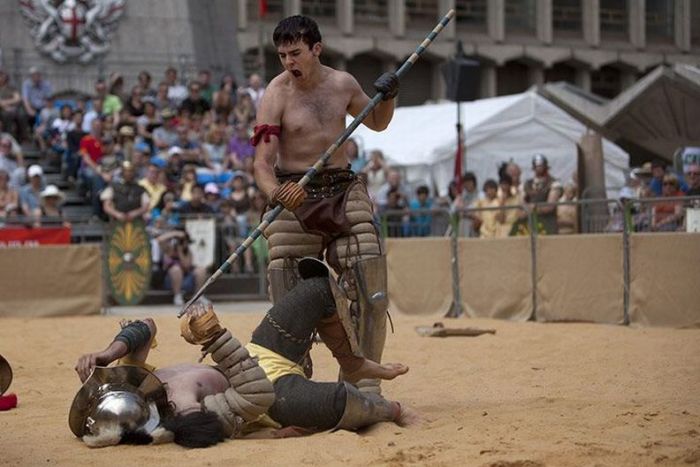|
|
Gladiator Fighting, London, United Kingdom
|
The war in Samnium, immediately afterwards, was attended with equal danger and an equally glorious conclusion. The enemy, besides their other warlike preparation, had made their battle-line to glitter with new and splendid arms. There were two corps: the shields of the one were inlaid with gold, of the other with silver...The Romans had already heard of these splendid accoutrements, but their generals had taught them that a soldier should be rough to look on, not adorned with gold and silver but putting his trust in iron and in courage...The Dictator, as decreed by the senate, celebrated a triumph, in which by far the finest show was afforded by the captured armour. So the Romans made use of the splendid armour of their enemies to do honour to their gods; while the Campanians, in consequence of their pride and in hatred of the Samnites, equipped after this fashion the gladiators who furnished them entertainment at their feasts, and bestowed on them the name Samnites. (Livy 9.40)
Livy's account skirts the funereal, sacrificial function of early Roman gladiator combats and underlines the later theatrical ethos of the gladiator show: splendidly, exotically armed and armoured barbarians, treacherous and degenerate, are dominated by Roman iron and native courage. His plain Romans virtuously dedicate the magnificent spoils of war to the Gods. Their Campanian allies stage a dinner entertainment using gladiators who may not be Samnites, but play the Samnite role. Other groups and tribes would join the cast list as Roman territories expanded. Most gladiators were armed and armoured in the manner of the enemies of Rome. The munus became a morally instructive form of historic enactment in which the only honourable option for the gladiator was to fight well, or else die well.
• Development
In 216 BCE, Marcus Ameilius Lepidus, late consul and augur, was honoured by his sons with three days of gladiatora munera in the Forum Romanum, using twenty-two pairs of gladiators. Ten years later, Scipio Africanus gave a commemorative munus in Iberia for his father and uncle, casualties in the Punic Wars. High status non-Romans, and possibly Romans too, volunteered as his gladiators. The context of the Punic Wars and Rome's near-disastrous defeat at the Battle of Cannae (216 BCE) link these early games to munificence, the celebration of military victory and the religious expiation of military disaster; these munera appear to serve a morale-raising agenda in an era of military threat and expansion. The next recorded munus, held for the funeral of Publius Liciniusin in 183 BCE, was more extravagant. It involved three days of funeral games, 120 gladiators, and public distribution of meat (visceratio data) – a practice that reflected the gladiatorial fights at Campanian banquets described by Livy and later deplored by Silius Italicus.
|
|









